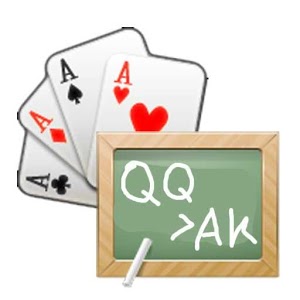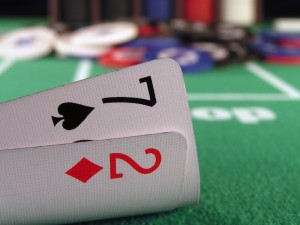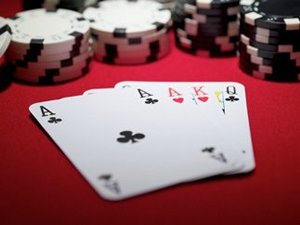Playing top two pair, and the nut-flush draw
Here are a couple of hands from a $2-$5 game at The Venetian in Las Vegas.
Hand No. 1: Top Two Pair
It’s $2-$5-$10 with an under-the-gun straddle. You ($2,600) are dealt the A Q
Q


















1. You should:
a. Fold
b. Call
c. Raise
2. You raise to $40, and it’s folded to the button ($500), who calls. The small blind ($500) calls, but the big blind folds. The straddler ($2,800), a fairly competent player, reraises to $210. The limper folds. You should:
a. Fold
b. Call
c. Reraise
3. You call. The button calls. The small blind folds. The flop comes A

















a. Fold
b. Call
c. Raise
Grades and Analysis
1. a(0), b(10), c(7). Note first that the players behind you are tight and/or have relatively short stacks. If any of them were tough players with deep stacks, raising with this hand from middle position would be a no-no, as you want to avoid playing big pots when out of position against tough players.
That said, this is probably too good a hand to fold, and whether or not you should raise is probably more a matter of taste than of right or wrong. If you are not comfortable playing with the initiative after the flop and/or are prone to making mistakes after the flop when you are the preflop raiser, you are better off limping in than raising. On the other hand, if you are comfortable playing with the initiative — whether it be in a shorthanded or a multiway pot — a suited-ace Broadway wrap with a wheel-card kicker may be worth kicking it up a notch.
That said, it is hard for limping in to be wrong, as raising with this hand in a full-ring game from middle position may be inappropriate for many players.
2. a(2), b(10), c(0). Sitting with 250 big blinds and position against a three-bettor, this may be a favorable opportunity. Folding would be a mistake unless you felt strongly that the three-bettor has to have A-A-X-X — but few competent players have to have A-A-X-X to three-bet here. Reraising (four-betting) is pretty much a no-no, not only because you don’t want to face a five-bet by an A-A-X-X, but also because doing so would serve primarily to negate your positional advantage by creating a very low stack-to-pot ratio (SPR) situation.
3. a(2), b(0), c(10). Here, you basically have a commitment decision. Not counting the $400 bet, there is $690 in the pot, and you have about $2,300 left, making this a low SPR situation (a two-bet situation in which the SPR is less than 4), although technically, there are more than two bets to play because the bettor underbet the pot. That said, the decision here is between jamming the pot and folding. And in a low SPR situation against a player who doesn’t have to have A-A-X-X, the play here is to raise and play for stacks if need be.
The third player in the hand doesn’t really factor into the decision, as he had less than one pot-sized bet remaining in his stack going to the flop.
In the actual hand, I raised to $1,875, and both opponents folded.
Hand No. 2: Nut-Flush Draw
It’s a $2-$5 game. You are dealt the A



































1. You should:
a. Fold
b. Call
c. Raise
2. You call. The small blind folds, but the big blind ($500) and limper both call. The flop comes Q

























a. Fold
b. Call
c. Raise
3. You call, and the first two players both fold. The turn is the K





a. Check
b. Bet
Grades and Analysis
1. a(10), b(6), c(0). This hand is more than a little speculative. It has three diamonds, with the suited ace the main feature, while the pair of nines has marginal set value. Much better would be the A





























2. a(5), b(10), c(0). A semibluff raise would be too creative here against a bet and a call, and with two players left to act who may be sandbagging. Despite the less than pot-sized continuation-bet, I would not write off the bettor’s hand, as I don’t see a good player trying to steal a $140 pot for $100 when he has six opponents on a board with two Broadway cards and a flush possibility, as the likelihood is that any bet will draw action. And while you have three diamonds in your hand and there are two players left to act, you are getting 3.4-1 on your call, you have the positional advantage, and you may have some implied odds.
All in all, it is probably a close decision. But, personally, if it is a close decision involving the nut-flush draw or nut-straight draw, I prefer to draw.
3. a(10), b(6). This is a very interesting decision point. You could check here and take the free card. On the other hand, both of your opponents checked the straight card, and with the two flush draws out and $445 already in the pot, I don’t see your opponents checking the nut straight here (although I suppose it’s possible). And if neither opponent has the nut straight, both might be willing to fold to a full pot-sized bet.
So, on one hand, it would be a mistake to bet here and get check-raised, but on the other hand, if neither opponent has the nut straight and both would be willing to fold to a bet, it also would be a mistake not to bet here. The real question is how strongly you feel that both of your opponents will fold if you bet and represent the straight.
In the actual hand, I bet $445 and both opponents folded. It’s interesting to note that while my decision on the flop was based on draw equity (tangible hand value based on both the direct and implied value of the nut-flush draw), it turns out that I also had some hidden float equity.
Submit your review | |








